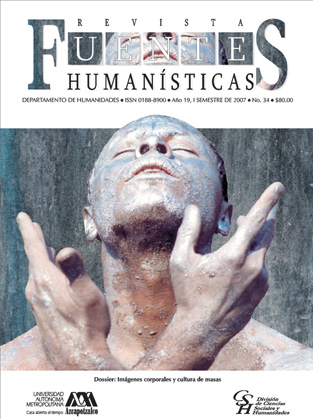El cuerpo humano como instrumento subcultural de los inicios del heavy metal al simbolismo ritual del black metal
Abstract
En el caso que aquí nos atañe, las manifestaciones corpóreas cargan un lenguajesimbólico que puede ser leído por los integrantes de una subcultura y, en consecuencia, puede ser diseccionado a partir de un ejercicio interpretativo. Decimos lo anterior en función de que la misma cultura, siguiendo a Millán (2001: 23), puede considerarse como un sistema de lenguaje articulado. Sobra decir que las significaciones corporales son una construcción social, por lo que su edificación varía de acuerdo con los ritmos históricos de aparición del saber y las tradiciones singulares de la cultura (Fournier y Jiménez, en prensa; Foucault, 1999).Downloads
References
BIBLIOGRAFÍA
Bourdieu, Pierre (1977) Outline of a theory
of practice, Cambridge, Cambridge
University Press.
Castillo, Stephen (2005) “El lenguaje
corporal y sus mensajes simbólicos:
Identidad, resistencia e ideología subcultural
del black metal”, en Memoria
electrónica del II Congreso Internacional
El Cuerpo Descifrado, México, Distrito
Federal.
Castoriadis, Cornelius (1989) [1975] La
institución imaginaria de la sociedad, t.
II, Barcelona, Tusquets Editores.
Collins, Randall (2004) Interaction ritual
chains. Princeton, Princeton University
Press.
Domínguez Prieto, Olivia (2001) “El Tianguis
del Chopo: Un espacio alternativo
en la ciudad”, en Cuicuilco 7 (22): 59-
, México, Escuela Nacional de Antropología
e Historia, Instituto Nacional
de Antropología e Historia.
Foucault, Michel (1999) [1970] La arqueología
del saber, México, Siglo
Veintiuno Editores.
Fournier, Patricia y Luis Arturo Jiménez
(2005) “Representaciones e interpretaciones
del chamanismo en el rock clásico:
El caso de Jim Morrison y The
Doors”, en Arqueología y Antropología
de las Religiones, Patricia Fournier y
Walburga Wiesheu (coords.), pp. 293-
, l caso de Jim Morrison y The
Doors”, México, INAH/ENAH.
Geist, Ingrid (2002) “Introducción”, en:
Antropología del Ritual. Víctor Turner,
compilado por Ingrid Geist, pp. 5-11,
México, INAH/ENAH.
Giddens, Anthony (1984) The constitution
of society, California, University of California
Press.
Herzog, Amy; Joanna Mitchell y Lisa Soccio
(1999) “Interrogating Subcultures”, en
Invisible Culture 2. An Electronic Journal
for the Visual Arts. http://www.rochester.
edu/in_visible_culture/issue2/introduction.
htm
Kosik, Karen (1966) Dialéctica de lo concreto,
México, Grijalbo.
Kuhn, Thomas (2004) [1962] La estructura
de las revoluciones científicas, México,
FCE.
Landy, Elliott (1994) Woodstock vision. The
spirit of a generation, Nueva York, The
Continuum Publishing Company.
Levi-Strauss, Claude (1978) Mitológicas. Lo
crudo y lo cocido, México, FCE.
(1991) Antropología estructural.
Mito, sociedad, humanidades, México,
Siglo XXI Editores.
Mauss, Marcel (1979) Sociología y antropología,
Madrid, Editorial Tecnos.
Mier, Raymond (1996) “Tiempos rituales
y experiencia estética”, en Procesos de
escenificación y contextos rituales,
compilado por Ingrid Geist; pp. 83-110,
México, Plaza y Valdés Editores.
Millán, Saúl (2001) “La etnología: una
interpretación de la cultura”. En Diario
de Campo, número 16, pp. 21-29,
México, INAH.
Moynihan, Michael y Didrik Soderlind
(2003) [1998] Lords of chaos: The bloody
rise of the satanic metal underground,
Londres, Feral House Books.
Muñiz García, Elsa y Mauricio List Reyes
(coords.) (en prensa), Corporeidad y
simbolismo comunicativo en el rock
clásico: El caso de Jim Morrison, en El
cuerpo Descifrado, México UAM-Azcapotzalco,
Benemérita Universidad
Autónoma de Puebla.
Nietzsche, Friedrich (2000) La genealogía
de la moral, Madrid, Alianza Editorial.
Palmer, Tony (1976) All you need is love.
The story of popular music, Nueva York,
Grossman Publishers, Viking Press.
Pareles, John y Patricia Romanowski (ed.)
(1983) The Rolling Stone Encyclopedia
of Rock&Roll, Nueva York, Summit
Books.
Pascual, Tomas (1997) “Retro-Thrash. From
the past comes the storm”, en Metal
Maniacs, octubre, vol. 14, núm. 4, pp.
-51; 66-69.
a “Emperor. Immortal beloved”. Metal
Maniacs, octubre, vol. 14, núm. 4, pp.
-74.
Stahl, Geoff (1999) Still “Winning Space?”
Updating Subcultural Theory. In[ ]visible
Culture 2. An Electronic Journal for the
Visual Arts. http://www.rochester.edu/
in_visible_culture/issue2/stahl.htm#11.
Tolkien, J. R. R. (1999) [1966] El señor de
los anillos. El retorno del rey, Barcelona,
Ediciones Minotauro.
Turner, Víctor (1980) La selva de los
símbolos, Madrid, Siglo XXI de España
Editores.
in_visible_culture/issue2/stahl.htm#11.
Tolkien, J. R. R. (1999) [1966] El señor de
los anillos. El retorno del rey, Barcelona,
Ediciones Minotauro.
Turner, Víctor (1980) La selva de los
símbolos, Madrid, Siglo XXI de España
Editores.
(1982) From ritual to theatre. The
human seriousness of play, Nueva York,
PAJ Publications.
(1995) [1969] The ritual process.
Structure and Anti-structure, Nueva York
Aldine de Gruyter.
Vogt Z., Evon (1983) [1976] Ofrendas para
los dioses, México, FCE.
Authors who publish in this journal accept the following conditions:
Fuentes Humanísticas is licensed under a Creative Commons Attribution-NonCommercial-ShareAlike 4.0 International (CC BY-NC-SA 4.0) license.
Authors retain copyright and grant the journal the right of first publication, with the work licensed under the Creative Commons Attribution license CC BY-NC-SA 4.0, which allows third parties to:
Share — copy and redistribute the material in any medium or format.
Adapt — remix, transform, and build upon the material.
The licensor cannot revoke these freedoms as long as you follow the license terms.
Under the following terms:
Attribution — You must give appropriate credit, provide a link to the license, and indicate if changes were made. You may do so in any reasonable manner, but not in any way that suggests the licensor endorses you or your use.
NonCommercial — You may not use the material for commercial purposes.
ShareAlike — If you remix, transform, or build upon the material, you must distribute your contribution under the same license as the original.
No additional restrictions — You may not apply legal terms or technological measures that legally restrict others from doing anything the license permits.
Authors may enter into other independent and additional agreements for the non-exclusive distribution of the published version of the article in this journal (e.g., placing it in an institutional repository) as long as they clearly indicate that the work was first published in this journal.






